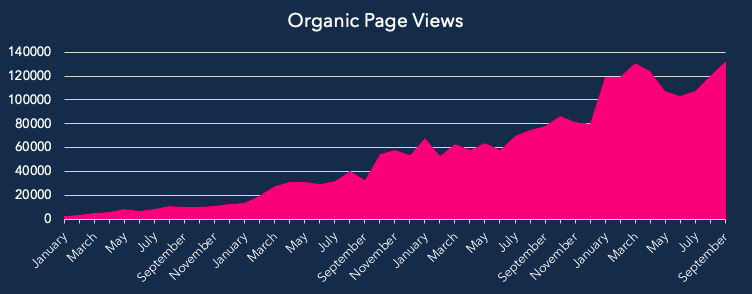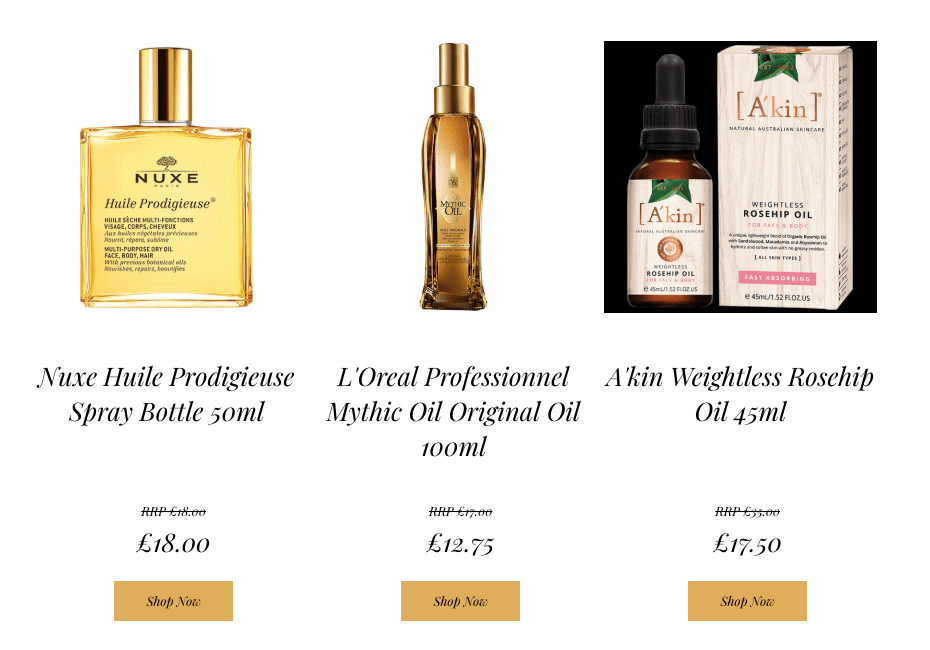Aside from a tonne of SEO benefits, blogs are a huge opportunity for brands to bring in organic traffic, sell their products and get returning visits. Sadly, eCommerce blogs are often given little thought, and as a result perform poorly, if they perform at all.
If you’ve tried and failed to make your eCommerce blog work in the past, or want to make sure you start one right, this is for you.
Jump To:
The Potential For A Successful Ecommerce Blog
Here’s a snapshot of organic traffic to a blog we created for a retail client in 2014. It now produces almost 150,000 organic visits per month. As you can see, it takes time, but they now have a steady stream of free traffic that increases each month.

So, you’ve seen that blogs can work for eCommerce brands. How do you achieve success?
Give Your Blog Real Purpose
Why does your blog exist?
Give it a purpose that goes beyond your product offering and looks at the essence of your market or niche. For example:
You Sell | Your Blog Could Be About
- Beds | Sleep
- Tools | Home Improvement
- Makeup | Health & Beauty
- Paint | Decorating & Interior Design
Then form a strategy that tackles content with one goal:
Help people within your target audience on that topic.
Your blog can and will generate traffic and return users, it will also generate revenue, but only if you can fulfil the first goal of being useful.
Once you’ve defined a purpose…
Don’t Call It A Blog
How many times have you been sat in the pub, cafe or crochet club reception and have someone recommend a company blog to you?
Never. The answer is never.
If your blog is advertised as such in your site navigation, email marketing and elsewhere it tells me a few things:
- You haven’t given it much resource.
- You haven’t given it much thought.
- It lacks purpose.
- It probably doesn’t perform.
Why?
There’s a lot of content on the web, meaning more competition, meaning your content will not perform unless it’s special. If it’s called ‘blog’, that likely means it lacks purpose, beyond being a place to put blog posts, which in turn means those blog posts aren’t special, which in turn means they won’t perform.
The best blogs within eCommerce are those that feel more like an online publication such as a digital magazine. Sure, the actual difference between a digital magazine and a blog is marginal, if there at all, but giving an impression that your blog is independent of you as sellers helps to enforce the idea that it exists to help and not to sell.
Pick a creative blog name that conveys its purpose. Here are a few I like:
Some thought is required on picking the right name, and there isn’t enough space here. But if you’re interested, here is a good post on choosing a great blog name. In a nutshell, the name needs to convey the purpose of the blog, be short enough for a tidy URL, and be able to come across as an independent publication.
Create Posts to Inform, Not Sell
Now you have a blog with a purpose, and a good name (and design) to reflect that, you need content.
Generating content ideas is a post in itself, but here are a few quick ways to get started:
How to generate good blog post ideas
-
- Answer The Public is a great, free resource that provides all the questions are prepositions around your topic. Fire in a keyword and see what comes out.
- Brainstorming is sometimes hit and miss but is invaluable if you have a strong creative team.
To get things started, ask questions like ‘what problems do people have within our niche?’ or ‘what, as experts, do we wish people knew about this topic?’ - Conduct Competitor Research to find similar content around the web.
Tools like Buzzsumo are great to find high-performing content by keyword, whereas Ahrefs will find the best content (by backlinks) if you want to analyse a specific competitor.
Optimise Your Posts For Web
A potentially huge list, but let’s keep it to the essentials:
Write descriptive titles
By all means, add a hook to your title, but steer away from cryptic, print-journalism-style headlines. For example, Bralet boom and why the underwire is under fire would be better as, “Consumer Interest In Underwired Bras Declines.”
Not because it’s a better title, but because search engines can crawl a more descriptive and straightforward title much easier.
Write in a structured way
Featured snippets are the theme of the year for many SEOs and content creators alike. One of the most reliable ways to get in those featured snippets is to add structure to your blog posts.
- Use <ol> or <ul> tags when the post is a list.
- Add tables when it will help the reader understand information
- Make sure your structured data is on point.
And finally,
Get to the point of your post, quick
If your post is trying to explain a question, or help users understand a complex issue, try and summarise the answer in the first paragraph, then give people further info or your supporting argument once you’ve answered the question.
This will increase the chance of you appearing in a paragraph-style featured snippet, but also ensure that users don’t bounce and look elsewhere in the SERPS for the answer, resulting in decayed rankings for your page.
Now Sell
If you’re applying all these things to your blog, you should expect to see results after 6-9 months on average.
Once you know you’ve got the formula right, you can think about product integration.
For products to drive revenue effectively in a blog, you should treat them almost as ads within an independent publishing platform.
Your ‘ads’ will likely be more effective, as there’s no one better at knowing which of your products are relevant to a certain topic or question as you.
The most basic way to do this is through text/image links, but if you want to add a little spice you can use something like our shoppable content Wordpress plugin that pulls products through from your xml feed like this:

Learn more about shoppable content.
What next?
Keep applying these principles and over time you should have a blog that provides a decent ROI.
Once you’ve got moving, take a look at our guide on managing and maintaining your content marketing platform.

